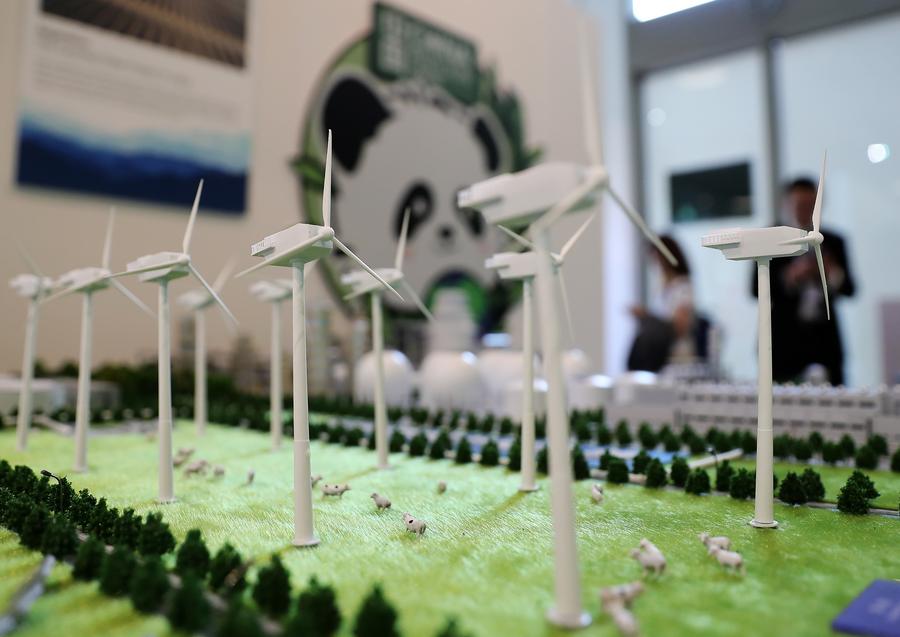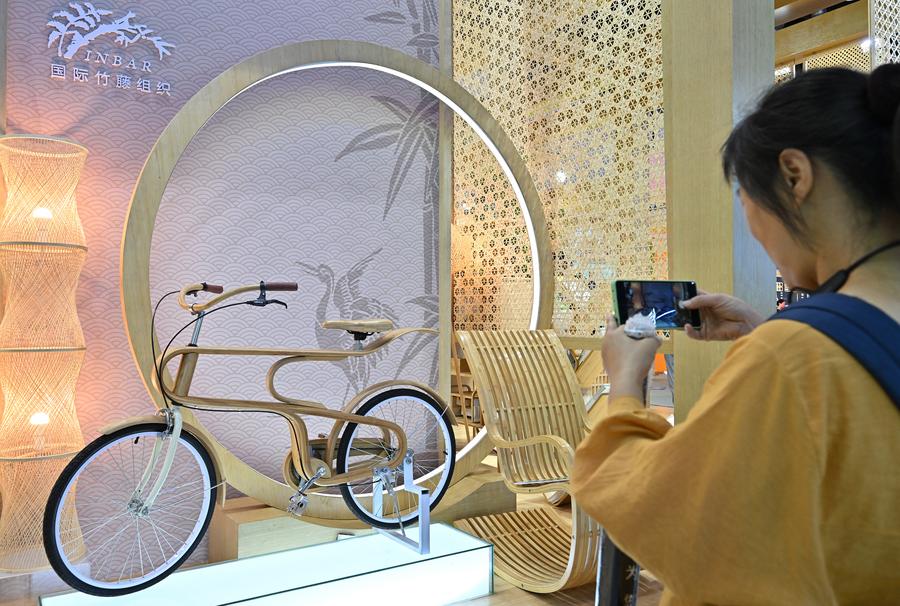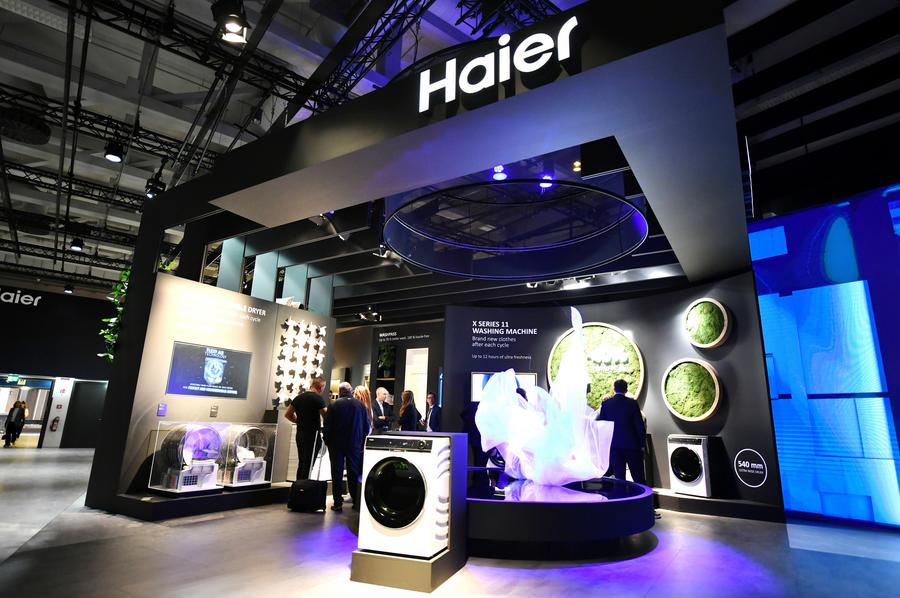Green patents boost innovative growth

This photo taken on Dec. 6, 2023 shows the model of wind turbine generators at China's pavilion of the 28th session of the Conference of the Parties to the United Nations Framework Convention on Climate Change, in Dubai, the United Arab Emirates. (Xinhua/Wang Dongzhen)
BEIJING, Aug. 16 (Xinhua) -- China's commitment to sustainable development has been bolstered by its strong green innovation, as evidenced by a recent report showing a 20 percent year-on-year increase in low-carbon patent applications, outpacing the global average.
Released by the China National Intellectual Property Administration (CNIPA), the patent report underscores China's pivotal role in propelling global green development. It reveals that in 2023, China's green and low-carbon invention patent applications soared to 101,000, accounting for more than half of the world's total.
The patent surge is particularly noticeable in the new-energy vehicle and solid-state battery sectors, which can be attributed to Chinese companies' investments in innovation.
Leading the charge is EV manufacturer NIO, which holds the industry's highest number of invention patents. In 2023, the Chinese company's total revenue reached 55.62 billion yuan (7.78 billion U.S. dollars), but it invested a staggering 13.43 billion yuan in technology research and development. As of June 2024, the decade-old automaker boasted a cumulative 9,000 global patent applications and grants.

This photo taken on Oct. 11, 2023 shows the NIO Second Advanced Manufacturing Base in Hefei, east China's Anhui Province.(Xinhua)
Xiaomi, a newcomer to the EV industry, has also secured a significant number of patents. Known for its smart consumer electronics, Xiaomi has placed a strong emphasis on technological advancements. Before the launch of its high-tech sedan in March, the company announced the acquisition of 60 patents in motor electronic control and 65 in battery technology within just two years.
Cost-effectiveness used to be the primary competitive advantage of domestic companies like Xiaomi in market penetration. However, they have now shifted their focus to IP efforts, as they realized that prioritizing innovation is the only way to achieve sustainable development.
Many EV companies have collaborated with universities and research institutions to pursue breakthroughs in critical technologies, such as advanced materials and smart driving systems. Most of their patents are high-value ones, focusing on battery safety, performance optimization and cost control. When entering global markets, these companies established an extensive patent framework covering the entire industry chain, from component design and manufacturing to vehicle integration and intelligence, from charging facilities to service networks.

A person takes selfies with Xiaomi's SU7 car during the Mobile World Congress in Barcelona, Spain, Feb. 26, 2024. (Xinhua/Gao Jing)
Besides the IP endeavors of enterprises, the country's IP regulators have also expedited patent review services for green and low-carbon technologies. The CNIPA has issued guidelines that prioritize patent examination for energy conservation and environmental protection applications.
According to Professor Song Hefa of the University of Chinese Academy of Sciences, prioritizing patent reviews and expediting the grant process provide a significant advantage to small enterprises and start-ups with limited financial resources. These entities can leverage their patent portfolios to attract investment opportunities.
"Shortening the review period enables these businesses to secure patent rights faster, which in turn can draw potential investors and expedite the realization and commercialization of their inventions," said Song.
The CNIPA has also offered analyses of global green and low-carbon technology patents annually to help enterprises gauge global innovation trends and chart the direction of their R&D investments.
Its Report on Statistical Analysis of Green and Low-Carbon Patents this year shows a record high year-on-year growth of published applications worldwide since 2017. Energy-storage patents dominated, with a 37.2 percent share and a 19.8 percent growth rate, while carbon capture, utilization and storage lagged at 6.7 percent. Among the clean energy sources, hydrogen energy showed the most rapid growth, emerging as a new innovation focus for many countries.
From 2016 to 2023, China maintained a growth trend in fields such as carbon reduction of fossil energy and energy saving, outperforming other major countries, according to the report.

A visitor takes photos of a bicycle made of bamboo at the environmental services exhibition of the 2023 China International Fair for Trade in Services in Beijing, capital of China, Sept. 2, 2023. (Xinhua/Li Xin)
China has set a national goal of reaching peak carbon emissions before 2030 and achieving carbon neutrality before 2060. It has been reinforced by a comprehensive approach to green and low-carbon development, which was emphasized in a resolution adopted at the third plenary session of the 20th Central Committee of the Communist Party of China in July.
The green transition is not only a national priority but also an integral part of everyday life. The country's commitment to low-carbon development has fostered a consumer market that values green consumption behaviors.
A 2023 consumption trend report shows that 73.8 percent of Chinese consumers prioritize green and environmentally friendly products or brands, with post-90s consumers showing the highest acceptance of green products.
The low-carbon preference is creating more opportunities for innovators. Household appliance giant Gree has submitted approximately 3,500 patent applications related to energy conservation and emission reduction. It boasts a "zero carbon source" air-conditioning patented technology that combines photovoltaic and energy storage systems, which can effectively reduce carbon emissions by almost 86 percent.

People visit the booth of Chinese company Haier during the IFA 2023 in Berlin, capital of Germany, on Sept. 1, 2023. (Xinhua/Ren Pengfei)
Haier, another leading enterprise, has also made significant efforts in energy-saving research. It collaborated with Xi'an Jiaotong University to develop a patented air-conditioning technology that enhances performance while reducing power consumption.
This week, the Chinese authorities have unveiled a guideline aimed at accelerating the green transformation across all facets of economic and social development. A key emphasis of this blueprint is the reinforcement of the creation, protection and utilization of IP in green and low-carbon technologies, invigorating innovation throughout society.
Propelled by both policy support and market demand, China is poised to witness a greater growth in green patents, which will continue to boost its innovative and sustainable development.?
Photos
Related Stories
- Chinese platform facilitates technological innovation of enterprises
- Chinese wastewater treatment project wins global innovation top prize
- Jiangsu builds "experimental fields" of basic research to unleash vitality for innovation
- Old industrial base sprints for revitalization through innovation
- China's central regions look to reform, innovation for high-quality development
Copyright © 2024 People's Daily Online. All Rights Reserved.









